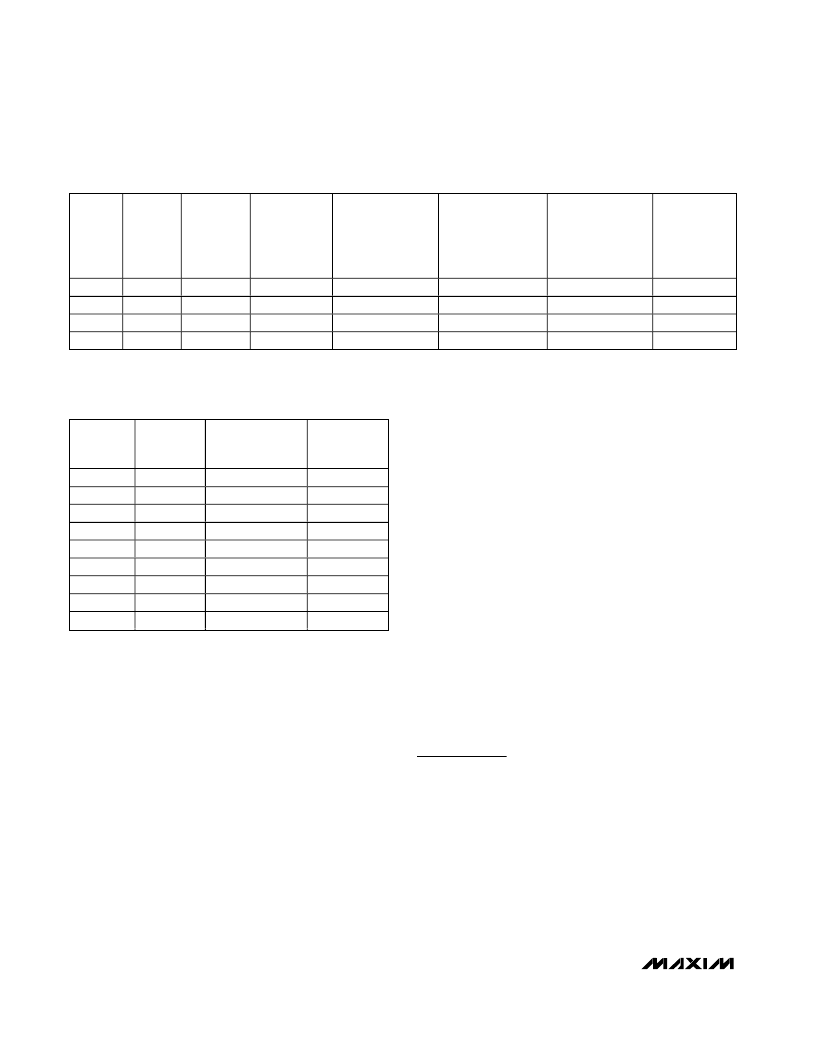- 您現(xiàn)在的位置:買賣IC網(wǎng) > PDF目錄385557 > MAX9770EUI (MAXIM INTEGRATED PRODUCTS INC) 1.2W Low-EMI, Filterless, Mono Class D Amplifier with Stereo DirectDrive Headphone Amplifiers PDF資料下載
參數(shù)資料
| 型號(hào): | MAX9770EUI |
| 廠商: | MAXIM INTEGRATED PRODUCTS INC |
| 元件分類: | 音頻/視頻放大 |
| 英文描述: | 1.2W Low-EMI, Filterless, Mono Class D Amplifier with Stereo DirectDrive Headphone Amplifiers |
| 中文描述: | 1.2 W, 2 CHANNEL, AUDIO AMPLIFIER, PDSO28 |
| 封裝: | 4.40 MM, MO-153AE, TSSOP-28 |
| 文件頁(yè)數(shù): | 16/24頁(yè) |
| 文件大小: | 493K |
| 代理商: | MAX9770EUI |
第1頁(yè)第2頁(yè)第3頁(yè)第4頁(yè)第5頁(yè)第6頁(yè)第7頁(yè)第8頁(yè)第9頁(yè)第10頁(yè)第11頁(yè)第12頁(yè)第13頁(yè)第14頁(yè)第15頁(yè)當(dāng)前第16頁(yè)第17頁(yè)第18頁(yè)第19頁(yè)第20頁(yè)第21頁(yè)第22頁(yè)第23頁(yè)第24頁(yè)

M
S hutdown
The MAX9770 features a 0.1μA, low-power shutdown
mode that reduces quiescent current consumption and
extends battery life. Drive
SHDN
low to disable the
drive amplifiers, bias circuitry, and charge pump. Bias
is driven to GND and the headphone amplifier output
impedance is 10k
in shutdown. Connect
SHDN
to
V
DD
for normal operation.
Clic k-and-Pop S uppression
Speaker Amplifier
The MAX9770 speaker amplifier features comprehensive
click-and-pop suppression that eliminates audible tran-
sients on startup and shutdown. While in shutdown, the
H-bridge is in a high-impedance state. During startup or
power-up, the input amplifiers are muted and an internal
loop sets the modulator bias voltages to the correct lev-
els, preventing clicks and pops when the H-bridge is
subsequently enabled. For 30ms following startup, a
soft-start function gradually unmutes the input amplifiers.
Headphone Amplifier
In conventional single-supply headphone drivers, the
output-coupling capacitor is a major contributor of
audible clicks and pops. Upon startup, the driver
charges the coupling capacitor to its bias voltage, typi-
cally half the supply. Likewise, during shutdown, the
capacitor is discharged to GND. This results in a DC
shift across the capacitor, which in turn, appears as an
audible transient at the speaker. Since the MAX9770
headphone amplifier does not require output-coupling
capacitors, this does not arise.
Additionally, the MAX9770 features extensive click-and-
pop suppression that eliminates any audible transient
sources internal to the device. The Power-Up/Power-
Down Waveform in the
Typical Operating Characteristics
shows that there are minimal spectral components in the
audible range at the output upon startup or shutdown.
In most applications, the output of the preamplifier dri-
ving the MAX9770 has a DC bias of typically half the
supply. During startup, the input-coupling capacitor is
charged to the preamplifier’s DC bias voltage through
the R
F
of the MAX9770, resulting in a DC shift across the
capacitor and an audible click/pop. An internal delay of
50ms eliminates the click/pop caused by the input filter.
Applic ations Information
Filterless Operation
Traditional Class D amplifiers require an output filter to
recover the audio signal from the amplifier’s output. The
filters add cost, increase the solution size of the amplifi-
er, and can decrease efficiency. The traditional PWM
scheme uses large differential output swings (2 x V
DD
peak-to-peak) at idle and causes large ripple currents.
Any parasitic resistance in the filter components results
in a loss of power, lowering efficiency.
1.2W Low-EMI, Filterless, Mono Class D Amplifier
with Stereo DirectDrive Headphone Amplifiers
16
______________________________________________________________________________________
Table 3. Gain Selection
GAIN1
GAIN2
SPEAKER
GAIN
(dB)
HEADPHONE
GAIN
(dB)
SPEAKER
OUTPUT
POWER
(V
IN
= 0.707V
RMS
)
(mW)
SPEAKER
OUTPUT
POWER
(V
IN
= 1V
RMS
)
(mW)
HEADPHONE
OUTPUT
POWER
(V
IN
= 0.707V
RMS
)
(mW)
HEADPHONE
OUTPUT
POWER
(V
IN
= 1V
RMS
)
(mW)
0
0
1
1
0
1
0
1
6
3
9
0
7
4
-2
1
500 / 4
250 / 4
500 / 8
124 / 4
500 / 8
500 / 4
1000 / 8
250 / 4
60* / 32
78 / 16
19 / 16
39 / 16
60* / 32
60* / 32
39 / 16
78 / 16
*
Output power limited to 60mW due to output voltage swing.
Table 4. Gain Settings with HPS
Connection
GAIN1
GAIN2
SPEAKER MODE
GAIN
(HPS = 0)
HEADPHONE
MODE GAIN
(HPS = 1)
HPS
HPS
0
1
HPS
0
0
1
1
0
1
6
3
6
9
6
6
3
9
0
-2
1
4
1
1
7
4
-2
1
HPS
HPS
HPS
0
1
0
1
相關(guān)PDF資料 |
PDF描述 |
|---|---|
| MAX9981 | 825MHz to 915MHz, Dual SiGe High-Linearity Active Mixer |
| MAX9981EGX-T | 825MHz to 915MHz, Dual SiGe High-Linearity Active Mixer |
| MAX9982 | 825MHz to 915MHz, SiGe High-Linearity Active Mixer |
| MAX9982ETP | 825MHz to 915MHz, SiGe High-Linearity Active Mixer |
| MAX9993 | High-Linearity 1700MHz to 2200MHz Down- Conversion Mixer with LO Buffer/Switch |
相關(guān)代理商/技術(shù)參數(shù) |
參數(shù)描述 |
|---|---|
| MAX9770EUI+ | 功能描述:音頻放大器 1.2W Low-EMI Class D Amplifier RoHS:否 制造商:STMicroelectronics 產(chǎn)品:General Purpose Audio Amplifiers 輸出類型:Digital 輸出功率: THD + 噪聲: 工作電源電壓:3.3 V 電源電流: 最大功率耗散: 最大工作溫度: 安裝風(fēng)格:SMD/SMT 封裝 / 箱體:TQFP-64 封裝:Reel |
| MAX9770EUI+T | 功能描述:音頻放大器 1.2W Low-EMI Class D Amplifier RoHS:否 制造商:STMicroelectronics 產(chǎn)品:General Purpose Audio Amplifiers 輸出類型:Digital 輸出功率: THD + 噪聲: 工作電源電壓:3.3 V 電源電流: 最大功率耗散: 最大工作溫度: 安裝風(fēng)格:SMD/SMT 封裝 / 箱體:TQFP-64 封裝:Reel |
| MAX9770EVKIT | 功能描述:音頻 IC 開發(fā)工具 Programmers, Development Systems RoHS:否 制造商:Texas Instruments 產(chǎn)品:Evaluation Kits 類型:Audio Amplifiers 工具用于評(píng)估:TAS5614L 工作電源電壓:12 V to 38 V |
| MAX9772EBA | 制造商:Maxim Integrated Products 功能描述:1.2WLOW-EMIFILTERLESSMONO CLASS - Rail/Tube |
| MAX9772EBA-T | 制造商:Maxim Integrated Products 功能描述:1.2W,LOW-EMI,FILTERLESS,MONO CLASS D AMP. W S - Tape and Reel |
發(fā)布緊急采購(gòu),3分鐘左右您將得到回復(fù)。